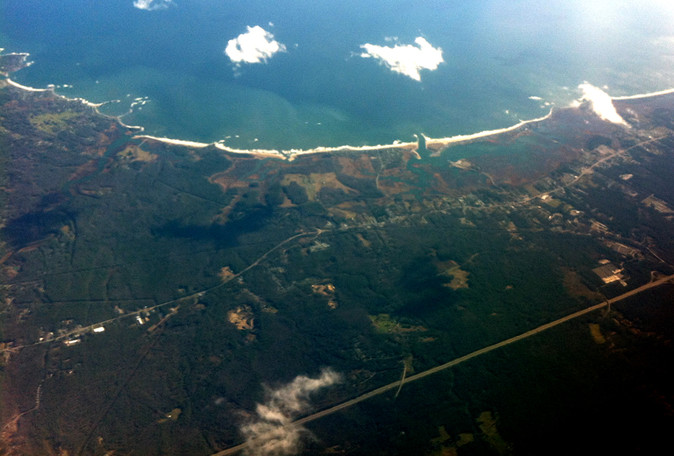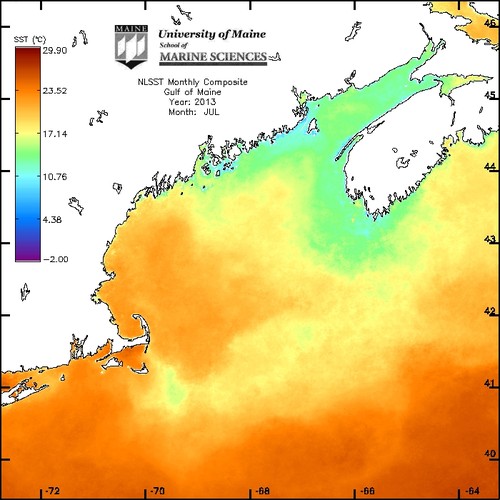The Wrack
The Wrack is the Wells Reserve blog, our collective logbook on the web.
The Wrack is the Wells Reserve blog, our collective logbook on the web.

The following was published in the Biddeford-Saco Journal Tribune Sunday edition, 11/24/13:
Many of the staff of the Wells Reserve at Laudholm were in West Virginia this past week for the annual conference of the 28 national estuarine research reserves. Researchers, educators, conservationists, land managers and even evangelists like me pulled ourselves away from our coastal homes to share ideas, hammer out new projects for 2014, and do some good old-fashioned colleague schmoozing.
I flew out of Portland on a sparkling, "unlimited visibility" Monday afternoon. My Southwest flight passed three miles above the Wells Reserve, giving me the rare opportunity to get a live bird's eye view of our little corner of the Maine coast. Looking down, I smiled quietly over how beautiful and tranquil the place looked.
But soon, other feelings crept up on my light mood as I gazed on the world below. The Saco River jetties jabbed like needles into the blue sea. Biddeford Pool dangled off the coast, exposed like a nerve. The houses along Old Orchard, Kennebunk, and Moody's beaches seemed to sit too closely to an edge drawn too sharply against the foaming surf. I looked down, and I saw danger.
The new FEMA flood maps were released earlier this month. Coastal flood insurance will, starting in January 2014, cost more in Southern Maine, because the floods and storms we thought were rare are rare no longer. While the danger zones migrated further inland, our homes did not. Our precarious perch on the coast was clear to me from the air, and I saw the same thing as we flew farther south over Boston, Long Island Sound, New York City, and the Jersey Shore.
In November 2012, Superstorm Sandy's wounds were still fresh. This year, Supertyphoon Haiyan similarly ravaged our fellow members of the human race on the other side of the world. At our coastal science conference this week, some of us discreetly made bets about this century's coming storms, fueled by indisputably warming ocean waters and exacerbated by the rising seas we're already seeing affect our salt marshes. I put money down that we would address these problems once they became impossible to ignore. Others were not so confident.
Our annual estuary conference, like Thanksgiving, brings the extended family back together. We all sit too much, eat and drink too much, and get into table-pounding debates. Of course we'll part company friends, probably even a little bit more in love with each other.
 I'm thankful that we can get together, that the government was open again so we had a place to meet and federal colleagues to greet. For all the camaraderie, though, I couldn't leave my worries in the sky above the Wells Reserve. The Gulf of Maine, like the ocean east of the Philippines, has heated up to abnormal levels. I'm thankful that our staff is studying this "phenomenon," its effects, and even how to deal with them. We'd be turkeys not to.
I'm thankful that we can get together, that the government was open again so we had a place to meet and federal colleagues to greet. For all the camaraderie, though, I couldn't leave my worries in the sky above the Wells Reserve. The Gulf of Maine, like the ocean east of the Philippines, has heated up to abnormal levels. I'm thankful that our staff is studying this "phenomenon," its effects, and even how to deal with them. We'd be turkeys not to.
Happy Thanksgiving, from all of us at the Wells Reserve at Laudholm.
Nik Charov is president of Laudholm Trust, the nonprofit partner of the Wells National Estuarine Research Reserve in Wells, Maine. His Sunday Journal Tribune column, "Between Two Worlds," ventures forth from the intersection of art and science, past and future, sturm und drang. More at wellsreserve.org/twoworlds.